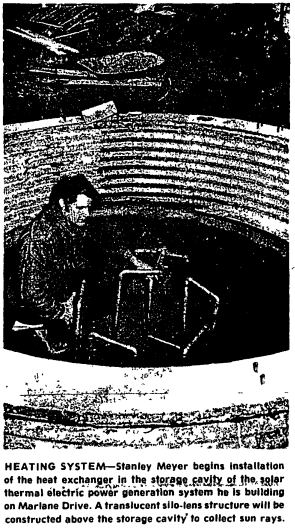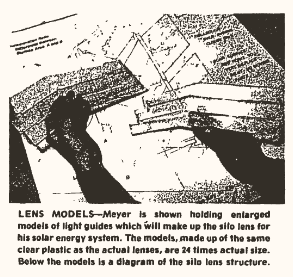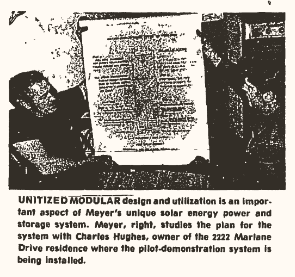Solar Energy: Local Project Could Solve National Crisis - March 18th, 1976
By Robert J. Tamasy
March 18th, 1976
Record Editor
 A revolutionary solar energy device being constructed just outside Grove City could have a phenomenal impact upon the national economy and the continuing search for cheap and plentiful sources of energy. But its inventor-designer says government officials at both the federal and state levels appear unwilling to give his concept any consideration.
A revolutionary solar energy device being constructed just outside Grove City could have a phenomenal impact upon the national economy and the continuing search for cheap and plentiful sources of energy. But its inventor-designer says government officials at both the federal and state levels appear unwilling to give his concept any consideration.
Stanley Meyer, of 1063 Urlin Ave., Columbus, last week told The Record he believes his recently patented “solar thermal electric power generation system” is vastly superior to flat-plate collector solar energy systems which are presently commanding national attention, but to date efforts he has made to communicate his ideas to officials in both Washington, D.C., and Columbus have been fruitless. He is hoping a planned July 4 demonstration of the pilot system he is building at the Charles Hughes home, 222 Marlane Drive, will change that attitude.
Meyer, who studied optics engineering, electronics and mechanics at the U.S. Army Engineering College in Washington, D.C., later was employed by a communications firm. He said his training in optics technology and his work on systems for national power plants had spurred him into developing the solar energy system.
Basic to the system is the commonly observed phenomenon of concentrating sunlight through a magnifying glass to burn a hole in a sheet of paper or a dry leaf.
The inventor said his system, which uses plastic lenses about one inch thick constructed into a silo-shaped translucent structure, creates a similar effect, using high temperatures, although instead of generating heat, the system focuses the energy for electricity production.
Meyer explained the system he is building locally will provide the energy needs for a two-story home—including electricity, heating, air conditioning, hot water, and gas for gas appliances—but adds it is applicable to commercial and industrial power sources.
He said “with only slight modifications” the system could be used to provide energy for individual homes, farm buildings, commercial structures, and it “is readily adaptable for many industrial uses.” Its unique heating system uses heat stored within available water plants, enabling vast amounts of energy to be stored and ultimately making available vast amounts of energy for future use, which he says will help offset our reserves.
Actual work on the new system did not begin until July, since Meyer was involved with designing and testing several other projects. He said much of the delay was because he was waiting for governmental and industry approval for his plans, which would take several years. However, he did not feel we could afford to wait that long for their solutions and decided to work on my own.”
He received a special U.S. energy patent on the system in December 1975, only about three months after filing the initial application, making it one of the fastest patents ever awarded.
After that, he began efforts to gain governmental support for the system. The attempts included a personal letter to Gerald Ford and a request to speak personally with Gov. James Rhodes, but in both cases there was “no response.”
 Meyer said he did succeed in speaking briefly with U.S. Rep. Samuel Devine (R-Columbus), who promised to arrange a meeting for him with prominent energy officials in Washington. That promise, however, resulted only in a five-minute talk with Samuel Taylor, whom Meyer said was “in charge of solar energy policies in Federal Energy Administration director Frank Zarb’s office.” Taylor said he was only interested in flat-plate collectors, according to the inventor.
Meyer said he did succeed in speaking briefly with U.S. Rep. Samuel Devine (R-Columbus), who promised to arrange a meeting for him with prominent energy officials in Washington. That promise, however, resulted only in a five-minute talk with Samuel Taylor, whom Meyer said was “in charge of solar energy policies in Federal Energy Administration director Frank Zarb’s office.” Taylor said he was only interested in flat-plate collectors, according to the inventor.
He was also discouraged in an effort to seek funding from the Federal Energy and Research Development Administration when he determined it would likely take more than a year for his application to be acted upon.
Private industry’s reaction to his solar energy system was no more promising. Meyer said the typical response to his invention was “a combination of greed and apathy.”
A revolutionary solar energy device being constructed just outside Grove City could have a phenomenal impact upon the national economy and the continuing search for cheap and plentiful sources of energy. But its inventor-designers say government officials at both the federal and state levels appear unwilling to give his concept any consideration.
Stanley Meyer, of 1063 Urlin Ave., Columbus, last week told the RECORD he believes his newly patented "solar thermal electric power generation system" is vastly superior to flat-plate collector solar energy systems which are presently commanding national attention, but to date efforts he has made to communicate his ideas to officials in both Washington, D.C., and Columbus have been fruitless. He is hoping a planned July 4 demonstration of the pilot system he is building at the Charles Hughes home, 222 Marlane Drive, will change that.
 Meyer, who studied optics engineering, electronics, and mechanical arts at the U.S. Army Engineering College in Washington, D.C. later worked with an optics and lens technician for a satellite installation affiliate company, said he developed the solar energy system he is constructing at home, using "new concepts based on known, proven principles."
Meyer, who studied optics engineering, electronics, and mechanical arts at the U.S. Army Engineering College in Washington, D.C. later worked with an optics and lens technician for a satellite installation affiliate company, said he developed the solar energy system he is constructing at home, using "new concepts based on known, proven principles."
Basic to the system is the commonly observed phenomenon of concentrating sunlight through a magnifying glass to burn a hole in a sheet of paper or a dry leaf.
The inventor said his system, which uses plastic lenses about one inch thick constructed into a silo-shaped translucent structure, creates a similar effect, using high-temperature rays, but the advantages of the system provide for heat retention, storage, and the generation of electricity.
Meyer explained the system he is building locally will provide electricity, heating, air conditioning, hot water, and other energy needs for the two-story home — including electric heating, air conditioning, hot water, and gas for gas appliances — but its design also makes it applicable for virtually any structure or need for any power source.
He said that "with only slight modifications" the system would be readily adaptable to many industrial uses, including heating buildings, commercial structures, residential homes, and ultimately making heat, vast amounts of energy released when the unclaimed oil is released from our oil reserves.
